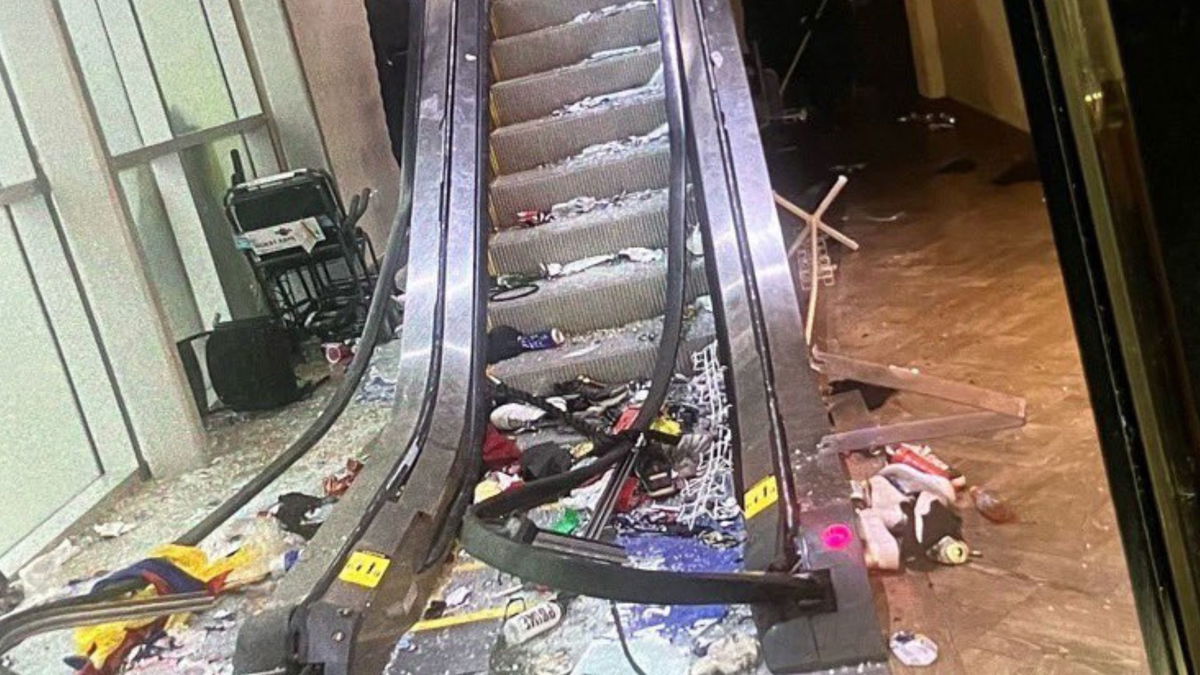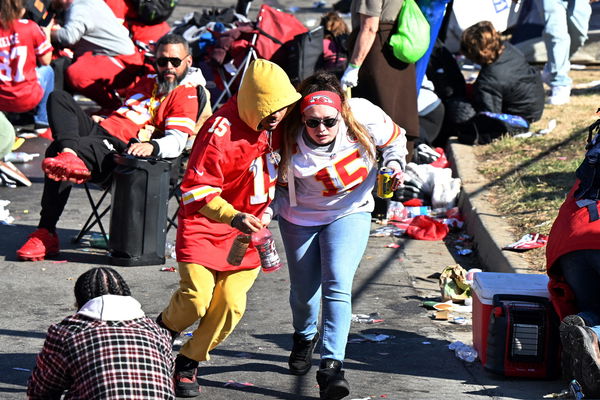

The Copa America final turned into a battle both on and off the pitch. As Argentina and Colombia slugged it out through 105 scoreless minutes, the real drama unfolded outside Hard Rock Stadium. Fans, driven by Messi-mania, unleashed chaos that left the venue’s reputation – and infrastructure – in shambles.
Watch What’s Trending Now!
“Thousands of fans without tickets tried to forcibly enter the stadium,” Hard Rock Stadium officials reported, their statement dripping with urgency. The result? A kick-off delayed by over an hour and a security nightmare that would make even the most seasoned bouncer sweat. A sellout crowd of more than 65,000 was expected, but the actual turnout spiraled out of control.
Dov Kleiman’s shocking photos revealed the extent of the carnage. The Dolphins’ prized 72 Club entrance? Reduced to a pile of twisted metal and broken dreams. Escalators lay in ruins, a stark reminder of the night’s frenzy. With home escalators costing up to $40,000 installed, the repair bill could easily hit six figures – a financial gut punch for the Dolphins.
ADVERTISEMENT
Wild: Fans are sneaking into the Hard Rock Stadium by crawling through the vents to watch the Copa América final.pic.twitter.com/MHGKH9QfwN
— Dov Kleiman (@NFL_DovKleiman) July 15, 2024
Desperation breeds ingenuity, and some fans took it to new heights – literally. Video footage showed supporters crawling through vents, in a Die Hard-esque bid for entry. The Miami-Dade Police Department’s response was swift and unequivocal: “Unruly behavior will get you ejected and/or arrested.”
One fan, Claudio from Mendoza, Argentina, painted a harrowing picture of the chaos. “They can’t organize a World Cup! It’s impossible,” he exclaimed to AP News, gesturing to his young son. “People stuck against the gate for hours, unable to breathe. There was a senior citizen, look at him, look at him, left without water. No water, nothing.”
ADVERTISEMENT
The scene outside was apocalyptic. Fans, mostly in Colombia’s yellow and red, leaped over security railings near the southwest entrance. They sprinted past overwhelmed officers and staff. In the mayhem, a young Argentina fan entered the gate sobbing, comforted by his guardian and a police officer – a poignant snapshot of the night’s emotional toll.
ADVERTISEMENT
Messi’s final bow marred by Hard Rock stadium scramble
Inside the stadium, a different drama unfolded. Lionel Messi, at 37, likely graced the Copa America stage for the last time. His premature exit, tears in his eyes after an ankle scare, wasn’t the fairytale ending many had hoped for.

Reuters
REUTERS/Agustin Marcarian
Argentina coach Lionel Scaloni’s pre-match words now seem prescient. He stood by earlier complaints about field conditions, adding that the team didn’t continue criticizing because “it could be interpreted as an excuse.” Little did he know, field conditions would be the least of their worries. The chaos outside cast a long shadow over what should have been Messi’s moment. As Colombia and Argentina battled through extra time, the real losers were already clear: the fans left outside and the tournament’s reputation.
ADVERTISEMENT
This Copa America final will be etched in memory, not for the action on the field, but for the pandemonium of it. It’s a stark reminder that in sports, the game isn’t always decided by what happens between the whistles. Sometimes, it’s the roar of the crowd – or in this case, the crash of broken barriers – that tells the real story.
Top Stories
Sean McDermott Announces Bad News for Josh Allen as Bills QB Rings Alarm Bells

Baltimore Ravens Make Kevin Stefanski Announcement After Firing John Harbaugh for Lamar Jackson Fallout

NFL Legend Terrell Owens, Terry Bradshaw’s Wife & More Share Messages After ICE Shooting Controversy

Veteran NFL Announcer Al Michaels Makes Decision on Retirement

Outcast CB Sends Strong Message to Jerry Jones After “Serious Loss” as Cowboys Owner Laments Mistake

The tournament’s organizers had their work cut out from the start. Earlier complaints about playing surfaces and a post-match melee following Colombia’s win over Uruguay had already tarnished the event’s image. Now, with this security meltdown, questions loom large over Hard Rock Stadium’s readiness for future events, including the 2026 World Cup.
As the dust settles and the repair bills roll in, one thing is clear: this wasn’t just a game. It was a perfect storm of passion, poor planning, and pandemonium. For Messi, for the fans, and for the beautiful game itself, it was a night that won’t be forgotten anytime soon- for all the wrong reasons.
ADVERTISEMENT
While the chaos at the Copa America final was alarming, it’s unfortunately not an isolated incident in the world of sports. Fan violence and security issues have been persistent problems across various sporting events, particularly in football (soccer) and American football.

USA Today via Reuters
Mandatory Credit: David Rainey-USA TODAY Sports TPX IMAGES OF THE DAY
A 2016 Washington Post investigation into NFL stadiums revealed a troubling trend of fan violence and arrests. The study found that arrest rates at NFL games had been slightly increasing since 2011, with an average of 6.34 arrests per game during the 2015 regular season. Notably, division contests and night games resulted in considerably more fan arrests, with the later kickoff times correlating to a higher likelihood of arrests.
ADVERTISEMENT
Some stadiums were particular hotspots for police activity. San Diego’s Qualcomm Stadium topped the list with 24.58 arrests per game between 2011 and 2015, followed by New York (21.96 arrests per game), Oakland (17.78), and Pittsburgh (16.75). These numbers highlight the ongoing challenge of maintaining order and safety at large sporting events.
The NFL has made efforts to improve stadium safety, including implementing a league-wide “code of conduct” and establishing text messaging lines for fans to anonymously report bad behavior. However, as the Copa America incident demonstrates, these issues are not limited to American football.
Tragically, stadium disasters have occurred worldwide, often with fatal consequences. In January 2022, a stampede at the Yaounde Olembe Stadium in Cameroon during an Africa Cup of Nations match resulted in at least eight deaths and 38 injuries. Even more recently, in October 2022, at least 129 people were killed in a stadium disaster in Malang, Indonesia, when fans stormed the pitch after a match.
ADVERTISEMENT
These incidents underscore the importance of proper security measures and crowd management at large sporting events. The Copa America final chaos, while severe, is part of a larger, global issue that sports organizations continue to grapple with.
As investigations into the Hard Rock Stadium incident continue, organizers of future events, including the 2026 World Cup, will likely be looking closely at the lessons learned. The challenge remains to balance the passion of fans with the critical need for safety and order, ensuring that the beautiful game doesn’t become marred by ugly incidents off the pitch.
ADVERTISEMENT
ADVERTISEMENT
ADVERTISEMENT

